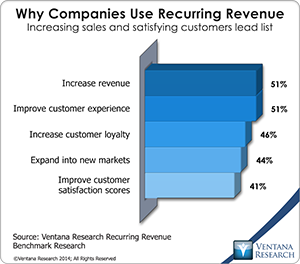For several years I have been advocating that sales organizations adapt their processes and applications to optimize both sales performance and the customer experience. For details see my research agenda for last year.
For several years I have been advocating that sales organizations adapt their processes and applications to optimize both sales performance and the customer experience. For details see my research agenda for last year. However, it appears that not many sales organizations have responded to this challenge; many can barely maintain their quarterly sales forecasts and monthly pipeline, track progress toward quotas and ensure that sales commissions are processed promptly and paid accurately. A great many are still using spreadsheets for these critical activities. Yet our benchmark research finds that more than half (61%) who use them for commissions said this makes the effort more difficult. Elsewhere, I have seen B2B sales organizations continue down the old path of annoying prospects with direct cold calling and email  instead of nurturing real relationships. For B2C sales, the digital age of search engine optimization (SEO) and pay-per-click (PPC) has begun to haunt prospects by inserting ads in our personal social media channels. My research suggests that these practices are not due to bad intentions but to force of habit and lack of desire, time and resources to develop a modern strategy and plan. Most are just managing the basics of their sales processes and relying on sales force automation (SFA) systems, reporting and dashboards, which will only produce more of the same, less than optimal results.
instead of nurturing real relationships. For B2C sales, the digital age of search engine optimization (SEO) and pay-per-click (PPC) has begun to haunt prospects by inserting ads in our personal social media channels. My research suggests that these practices are not due to bad intentions but to force of habit and lack of desire, time and resources to develop a modern strategy and plan. Most are just managing the basics of their sales processes and relying on sales force automation (SFA) systems, reporting and dashboards, which will only produce more of the same, less than optimal results.
This won’t do in 2016 as many factors have changed. Strong emphasis on achieving revenue targets and increasing pressure by and on sales management to provide complete and useful information and satisfying experiences to their prospects and customers. Those that don’t succeed are likely to fall further behind the competition in their pursuit of sales excellence. For those serious about improving all aspects of sales, from planning to result, I offer some suggestions.
Organizations that generate revenue through sales to consumers and business with digital commerce often continue to use systems that do not include capabilities to optimize the customer experience. Our preliminary research finds a number of them examining their systems to determine whether the “click to order” paradigm is not very efficient and able to engage customers and provide all the product information they want. Most digital commerce systems are ineffective in managing product information let alone being able to replicate product records from an enterprise master source. Antiquated commerce systems cannot support the latest digital attributes of products such as images, videos, reviews and feedback that motivate customers to go from browsing to purchase. Having consistent product information across all channels of interaction is now a necessity that requires product information management (PIM) processes and systems. This is not primarily a responsibility of the sales group but of marketing and the product organization, but it affects all of them. To address it we see partnerships developing between PIM and commerce providers who have realized the need for better support that results in purchases.
 A growing approach to sales is recurring revenue and subscription methods of payment. Our research on the topic finds good reasons for this change, the most common (for 51%) being to increase revenue and improve the customer experience. But most organizations are not well equipped to make this shift. They must integrate new processes with their digital commerce systems to support a variety of subscriptions and charges that require effective dating and billing methods. We will track the momentum of recurring revenue in new benchmark research on next-generation product information management and determine best practices in building a unified commerce approach that blends management of products and customer experience to energize sales. We will also assess the vendors and products that best fit these requirements in our 2016 PIM Value Index.
A growing approach to sales is recurring revenue and subscription methods of payment. Our research on the topic finds good reasons for this change, the most common (for 51%) being to increase revenue and improve the customer experience. But most organizations are not well equipped to make this shift. They must integrate new processes with their digital commerce systems to support a variety of subscriptions and charges that require effective dating and billing methods. We will track the momentum of recurring revenue in new benchmark research on next-generation product information management and determine best practices in building a unified commerce approach that blends management of products and customer experience to energize sales. We will also assess the vendors and products that best fit these requirements in our 2016 PIM Value Index.
Continuous optimization of existing processes is not feasible using conventional sales activities and tools, as I have pointed out. It is common to find a disparate collection of sales applications, usually loosely coupled, centered on the SFA or sales compensation system and expanding into forecasting, opportunity management, quota and territory management, analytics and reporting. Today, however, sales compensation systems are available that do more than automate and integrate sales operations with finance and include sales performance management with quota, territory, learning and analytics designed to improve sales outcomes. Such sales compensation systems are more effective in managing incentives and rewards than are using spreadsheets. Some vendors have added internal compensation benchmarking to ensure equal pay is provided for equal work across genders and ethnicities. Innovative but not widely used yet are automation of sales contests and team-based scoreboards that, using gamification, can rally a whole sales organization toward individual, group or overall objectives. Similarly providing continuous recognition of the sales force can be part of broad- or narrowcast communications. Our sales compensation management benchmark research finds that providing recognition to top performers is critical to more than half (53%) of organizations.
For the majority in sales the ability to see their progress toward quota, commissions earned and available potential territory is not  readily available in the business intelligence software managed by IT, and analytics designed for visual discovery will not meet the full sales organization’s needs. In most cases the analytics and visualization is too complicated and is not able to be narrated and contextualized through text let alone be able to collaborate on the information. Now a new generation of analytics and sales performance applications are beginning to fill the void. In many cases the analytics are simpler and more informative and already interpreted and in the form of notification or natural language that you can read and are easily accessible on mobile devices. And for some of the elites in sales management who are getting notifications on their smart watches like the Apple Watch. For its part sales management needs to be able to continuously plan sales efforts by performing what-if scenarios and assessing trade-offs on promotions and incentives; this cannot be done with spreadsheets. Our next-generation business planning research finds that spreadsheets make it difficult to manage sales and operations planning (S&OP) processes in more than half (51%) of organizations. Additionally only 10 percent of organizations said they have all the numbers needed to understand trade-offs in S&OP, and fewer than half (43%) are satisfied with their process. This sort of dissatisfaction is leading organizations to assess new systems for S&OP and not much is different in sales forecasting. Our research into business planning finds that sales is less than effective and operate below average compared to all areas of the organizations. Also available today are sophisticated analytics-driven sales forecasting and pipeline optimization applications that provide visibility into the impacts of sales efforts; these could help the one-quarter of organizations that take two weeks or longer to compare actuals to the forecast to find variances.
readily available in the business intelligence software managed by IT, and analytics designed for visual discovery will not meet the full sales organization’s needs. In most cases the analytics and visualization is too complicated and is not able to be narrated and contextualized through text let alone be able to collaborate on the information. Now a new generation of analytics and sales performance applications are beginning to fill the void. In many cases the analytics are simpler and more informative and already interpreted and in the form of notification or natural language that you can read and are easily accessible on mobile devices. And for some of the elites in sales management who are getting notifications on their smart watches like the Apple Watch. For its part sales management needs to be able to continuously plan sales efforts by performing what-if scenarios and assessing trade-offs on promotions and incentives; this cannot be done with spreadsheets. Our next-generation business planning research finds that spreadsheets make it difficult to manage sales and operations planning (S&OP) processes in more than half (51%) of organizations. Additionally only 10 percent of organizations said they have all the numbers needed to understand trade-offs in S&OP, and fewer than half (43%) are satisfied with their process. This sort of dissatisfaction is leading organizations to assess new systems for S&OP and not much is different in sales forecasting. Our research into business planning finds that sales is less than effective and operate below average compared to all areas of the organizations. Also available today are sophisticated analytics-driven sales forecasting and pipeline optimization applications that provide visibility into the impacts of sales efforts; these could help the one-quarter of organizations that take two weeks or longer to compare actuals to the forecast to find variances.
Other advances include applications to support the full order-to-cash sales process, and some evolving from configure price quote (CPQ) efforts are demonstrating a more effective process-centric approach that provides the workflow and extensibility missing in SFA. And CPQ has been a critical application that is absorbed through vendor acquisition into larger sales application suites. For B2B organizations this approach can help reduce friction and delays in closing deals and support revenue recognition that acknowledges delivery of goods or receipt of services. For others, contract automation software can help ensure consistency of legal terms and authorize signatures that historically have been delayed by email and stages in the sales pipeline.
Sales groups should expect more from their marketing colleagues in the development of quality product information and materials to support the sales process. Many industry efforts in sales asset management aimed at gaining more consistency in materials have fallen short but are essential to sales effectiveness. For many sales organizations more direct coaching and working with account managers can help guide them on the path to their objectives. More than one-third of organizations are planning to use or are evaluating collaborative coaching, according to our sales compensation benchmark research. But marketing, not sales, should be responsible for nurturing suspects into becoming prospects and tracking the interactions that properly prepare leads for sales to manage into its funnel. Experimentation with sales lead nurturing is a response to marketing’s inability to fulfill on its demand-generation efforts. It will take time to see whether these new applications for sales can help increase productivity and ultimately sales. In any case, continuing separate efforts of the marketing and sales functions can only pull these organizations farther apart and undermine the success of the enterprise.
I recently pointed out the digital technology agenda and resulting disruptions to business that led to a new generation of sales applications and tools available from the vendors serving this market segment. In particular we have begun to see better use of predictive analytics to score sales leads on the probability of purchase within a given time period, which brings sales more valuable insights than dashboards and reports do. Our next-generation predictive analytics research reveals that more sales organizations than I realized (38%) are already using them. We will publish more research on next-generation sales analytics in 2016, and I have already given a look at this focus.  Elsewhere, time in sales operations spent on tasks like data preparation can be reduced by new tools or applications that have these capabilities built in. In another disruptive area advances in social collaboration enable digital interaction across an organization to share opportunities and address issues. Using video to provide training through learning management systems (LMS) or real-time exchange of information is critical for sales, too. It is clear that all systems and information that people in sales use should be readily available on mobile devices; look for products that do not require frequent pinching in and out of the user experience. Keep in mind that all of these applications for sales can be accessed through software as a service and cloud computing, which may be easier to deploy and less costly than doing it in-house.
Elsewhere, time in sales operations spent on tasks like data preparation can be reduced by new tools or applications that have these capabilities built in. In another disruptive area advances in social collaboration enable digital interaction across an organization to share opportunities and address issues. Using video to provide training through learning management systems (LMS) or real-time exchange of information is critical for sales, too. It is clear that all systems and information that people in sales use should be readily available on mobile devices; look for products that do not require frequent pinching in and out of the user experience. Keep in mind that all of these applications for sales can be accessed through software as a service and cloud computing, which may be easier to deploy and less costly than doing it in-house.
People outside of sales also should realize the need for investments in core applications including digital commerce, product information management and sales performance management. In 2016 we will release our value index on sales performance management that will assess and rate vendors and products. Our research shows that in more than half (59%) of organizations Finance plays a key role to influence and sponsor investments for the sales organization. Heads of sales organizations likewise should know that their sales operations team needs time and resources to better support the sales force. Putting applications on mobile devices with an easy and familiar user experience can further engages sales reps to get out and accomplish what they are chartered to do: sell. Furthermore, to stay strong sales organizations will have to invest in developing their talent and make recruiting efforts more effective. The alternative is less than promising. Sales organizations should be active in taking control of their destiny and supercharging their efforts in 2016.
Regards,
Mark Smith
CEO and Chief Research Officer
Filed under: Business Analytics, Business Collaboration, Business Performance Management (BPM), Customer Performance Management (CPM), Financial Performance Management (FPM), mobile technology, Operational Performance Management (OPM), Predictive Analytics, Uncategorized Tagged: Sales, SFA, SPM, Sales Performance Management, Sales Compensation, Sales Forecasting, Commerce, PIM, Product Information Management, Recurring Revenue, Digital Commerce
![]()







